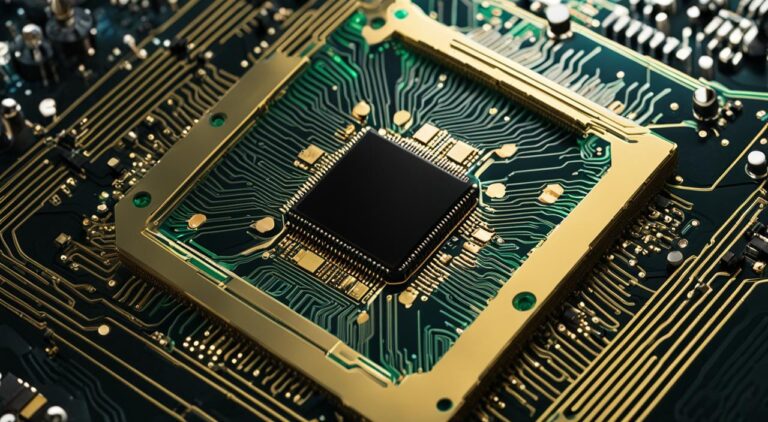How Much Voltage Does a Computer Use? (Factors and Volts)

A computer typically uses a voltage of around 110-240 volts.
With that answer, now im going indepth on this topic and i will clear everything that you need to know on this topic. So make sure to stay till the end to get a clear idea.
What is The Voltage Requirements for A Computer?
The voltage requirements of a computer can vary depending on several factors. These factors include the type and power consumption of the components installed in the computer system.
Each component within a computer requires a specific voltage to function properly. For example, the motherboard typically operates at a voltage range of 12 volts for power delivery. The CPU, on the other hand, may require a lower voltage, such as 1.2 volts or 1.3 volts, for efficient operation.
Other components, such as hard drives and graphics cards, may have their own voltage requirements as well. Hard drives typically operate at 5 volts, while graphics cards may require a range of voltages depending on their power needs.
It is important to ensure that the power supply unit (PSU) in a computer is capable of providing the necessary voltages to all the components.
Knowing the voltage requirements of a computer is crucial for ensuring proper functionality and preventing damage to the components. It is recommended to consult the specifications provided by the component manufacturers to determine the specific voltage requirements for each component.
Role of Power Supply in Delivering Appropriate Voltage
The power supply of a computer plays a crucial role in delivering the appropriate voltage to various components. It ensures that the computer receives stable and consistent voltage, which is essential for proper functionality.
The standard output voltages of a computer’s power supply are +3.3 volts, +5 volts, and +12 volts. These voltages power different components such as the motherboard, CPU, storage devices, and graphics card.
Having stable and consistent voltage is important as it ensures that the components receive the required power without any fluctuations.
Fluctuations in voltage can cause damage to the components and lead to system instability. Additionally, stable voltage helps in achieving optimal performance and avoids crashes or system failures.
By maintaining a stable voltage, the power supply ensures that all components receive adequate power and function properly. It is recommended to use a high-quality power supply that can supply the required voltage consistently to avoid any potential issues.
Measuring The Voltage Of Your Computer
Measuring and understanding the voltage of your computer is essential for troubleshooting and making sure your computer is operating properly.
There are different methods to measure the voltage used by a computer, and certain tools or equipment needed for accurate measurement.
One method to measure the voltage is by using a digital multimeter. This device allows you to measure the voltage levels of various components within your computer, such as the power supply, motherboard, and other peripherals.
Another method is to use software tools specifically designed for measuring computer voltages. These tools provide real-time monitoring and can give you detailed information about the voltage levels of your computer’s components.
When measuring the voltage, it’s important to follow the proper steps and interpret the readings correctly. You should consult the user manual or online resources for specific instructions on how to measure voltage for your particular computer.
Measuring the voltage of your computer is crucial for troubleshooting and ensuring its proper functioning. By using the right tools and following the appropriate steps, you can accurately measure and interpret the voltage levels of your computer’s components.
Managing Power Consumption For Efficiency
Managing power consumption is crucial for ensuring efficiency and reducing energy waste in computers. Knowing the relationship between voltage, power, and energy consumption is essential.
When it comes to optimizing power usage without compromising performance, there are several tips to keep in mind. Firstly, adjusting the power settings on your computer can have a significant impact.
Lowering the brightness of your screen, enabling sleep mode, and setting shorter time intervals for standby mode can all help conserve power.
Additionally, choosing energy-saving practices such as turning off peripherals when not in use and utilizing power management software can further reduce energy consumption.
It is also important to consider the environmental impact of our computers. Recycling old devices, purchasing energy-efficient equipment, and reducing unnecessary power usage are all ways to minimize our carbon footprint.
By implementing these strategies, we can effectively manage power consumption and contribute to a greener future.
What are Computer Power Supplies?
The power supply unit (PSU) plays a crucial role in a computer by supplying power to the various components. It converts the AC (alternating current) voltage from the electrical outlet into DC (direct current) voltage that the computer can use.
A PSU consists of several components that work together to ensure stable and reliable power delivery. These components include transformers, rectifiers, capacitors, and voltage regulators.
Transformers convert the high-voltage AC power from the outlet to the desired voltage levels, while rectifiers convert AC to DC. Capacitors help in storing and smoothing the DC power, and voltage regulators ensure a constant voltage output.
There are different types of PSUs available, categorized by their wattage capacity and form factor. The voltage capacity of a PSU varies depending on the specific type and model. Common voltage outputs for a computer’s power supply include +3.3V, +5V, and +12V. These voltages are used by different components such as the motherboard, graphics card, and storage devices.
Difference Between Voltage And Watts In Computers
Understanding the distinction between voltage and power consumption is crucial when it comes to determining how much voltage a computer uses.
Voltage refers to the force at which electric current flows, measured in volts, while power consumption, measured in watts, indicates the amount of electrical energy consumed by a device.
When calculating the overall voltage requirement based on component specifications, it is essential to consider the standard output voltages of a computer’s power supply. Additionally, the relationship between voltage and wattage in computer operation is important to ensure the optimal functioning of the system.
It is worth noting that the power supply unit (PSU) in a computer plays a crucial role in converting the alternating current (AC) from the power outlet to the direct current (DC) required by the components.
This is why computers primarily use DC instead of AC. Understanding how PC power supplies work can provide valuable insights into the voltage requirements of a computer system.
Significance Of Direct Current (dc) In Computers
The significance of direct current (DC) in computers is evident in their predominant use of DC instead of alternating current (AC). There are several advantages to using DC voltage in computer systems:
1. Efficiency: DC power is more efficient than AC power as it eliminates the need for power conversion, which can result in energy loss. This efficiency translates into lower power consumption and reduced operating costs.
2. Stability: DC voltage provides more stable and consistent power delivery, which is crucial for the reliable operation of computer components. It helps prevent sudden fluctuations or surges that can damage sensitive electronic circuits.
3. Compatibility: Many computer components, such as integrated circuits and microprocessors, require low voltage DC power to function properly. By using DC voltage, computers can provide the precise power levels needed by these components.
The power conversion within a computer involves converting the incoming AC power from the wall outlet into DC voltage that can be used by the computer’s components.
This conversion is typically performed by the power supply unit (PSU) in the computer, which transforms the AC power into multiple DC voltages, such as 12V, 5V, and 3.3V, as required by different components.
The use of DC voltage in computers offers various advantages, including efficiency, stability, and compatibility with critical components. The power conversion process ensures that the different components receive the specific DC voltages they need to operate effectively.
Exploring Voltage Requirements Of Peripheral Devices
When it comes to the voltage needs of fans in a computer system, it is important to understand that different fans may have different voltage requirements.
Typically, fans in a computer system operate at 12 volts. However, there are also fans that operate at 5 volts or even 24 volts.
It is important to check the manufacturer’s specifications to determine the voltage requirements of the specific fan model being used. The voltage requirements of fans are crucial as using the wrong voltage could result in improper functioning or damage to the fan.
Computer monitors and televisions generally require a standardized voltage input of around 100-240 volts AC.
These devices often come with an external power supply, known as an AC adapter or power brick, to convert the voltage from the mains supply to the required level.
The AC adapter typically provides a stable DC output to power the monitor or television. It is important to ensure that the voltage and wattage rating of the AC adapter match the requirements of the specific monitor or television to avoid any electrical issues or damage.
In addition to fans, computer monitors, and televisions, various other peripheral devices also have specific voltage requirements. These include devices such as hard drives, optical drives, keyboards, mice, and USB devices.
Typically, these devices operate at 5 volts or 12 volts. It is important to consult the manufacturer’s specifications or user manuals to determine the exact voltage requirements of these peripheral devices.
Using the wrong voltage could lead to device malfunction or damage. Additionally, it is important to provide the necessary power supply connectors, such as SATA or molex connectors, to ensure proper power delivery to these devices.
Ensuring Electrical Safety For Computer Systems
Computer systems typically use a standard voltage range for efficient operation. While the specific voltage requirements can vary depending on the components and configurations, it is important to ensure electrical safety by following best practices for handling wiring and connections.
This includes using appropriate voltage-rated components to prevent electrical hazards. It is recommended to research the voltage requirements of the specific components being used and consult the manufacturer’s guidelines.
Additionally, measuring the voltage that a computer uses can provide insight into its power utilization. The power supply unit of a computer typically provides the standard output voltages, which can vary depending on the model.
Understanding and calculating the overall voltage of the PC components can help ensure proper functionality. It is worth noting that computer power supplies convert AC to DC voltage for the internal components. By using the appropriate voltage and following electrical safety guidelines, the risk of electrical mishaps can be minimized.
Frequently Asked Questions Of How Much Voltage Does A Computer Use
Do Computers Operate At 120 Volts?
Computers typically operate at 120 volts.
Why Do Computers Need 12 Volts?
Computers need 12 volts to power various components, such as the motherboard and hard drives. This voltage is necessary for efficient and reliable operation. Using direct current (DC) instead of alternating current (AC) ensures stable and consistent power delivery.
Why Do Computers Use 5 Volts?
Computers use 5 volts because it is a standard voltage level that provides enough power for different components to function properly. This voltage is efficient for running various electronic devices and ensures compatibility across different computer systems.
How Much Electricity Does A Computer Use?
A computer typically uses around 100 to 400 watts of electricity. The exact amount depends on factors such as the computer’s hardware and usage.
To determine how much voltage a computer uses, it is essential to consider the power supply unit. A typical power supply for a computer consists of various output voltages, including +12V, +5V, and +3. 3V. These voltages are crucial for the functioning of different hardware components such as the processor, memory, and graphics card.
Understanding the voltage requirements of your computer is essential for maintaining optimal performance and preventing any potential issues. It is recommended to consult the specifications of your computer’s power supply to ensure it is delivering the correct voltages for your system’s needs.






